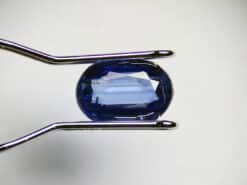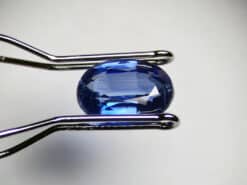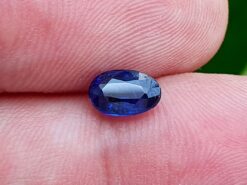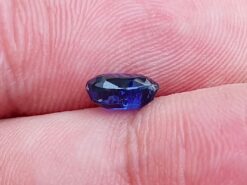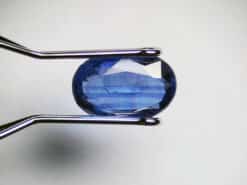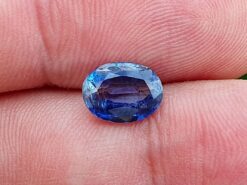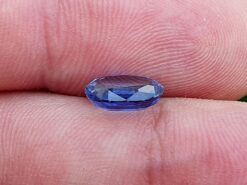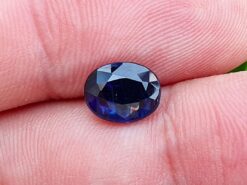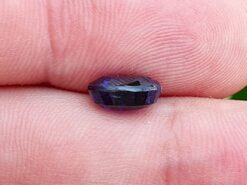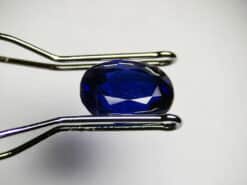Orange kyanite
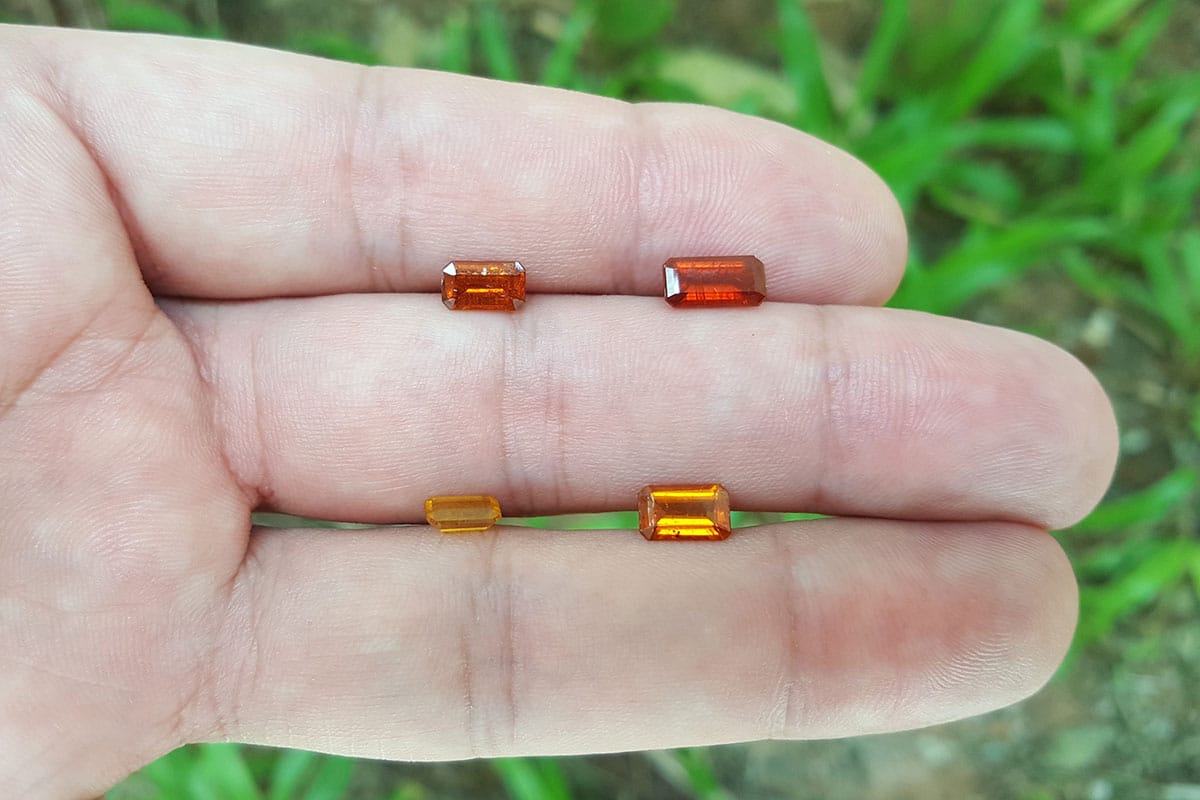
Buy natural kyanite in our shop
Orange kyanite meaning, healing and metaphysical properties
Orange kyanite is a striking variety of the typically blue silicate mineral known as kyanite. Found in aluminium-rich metamorphic pegmatites and/or sedimentary rocks, kyanite is recognized for its unique crystalline structure and anisotropic properties. While classic kyanite is most famously blue, the vibrant orange version of this mineral is far less common, making it particularly intriguing for both collectors and enthusiasts. Orange kyanite frequently hails from Tanzania, where specific geological conditions and the inclusion of small amounts of manganese (Mn3+) yield its characteristic warm hue. In addition to its rarity and beauty, this remarkable stone symbolizes energy, creative inspiration, and spiritual balance.
In metamorphic rocks, kyanite usually indicates the presence of high-pressure conditions, generally above four kilobars. Although it can theoretically form under lower pressures and lower temperatures, the naturally high activity of water during metamorphism often leads to the stone being replaced by hydrous aluminosilicates such as muscovite, pyrophyllite, or kaolinite before it has a chance to fully stabilize. Still, under the right conditions, kyanite takes shape, occasionally forming vibrant orange crystals that stand apart from the more common blue variety.
Kyanite has multiple polymorphs, sharing its general chemical composition with andalusite and sillimanite. All three belong to the aluminosilicate series. The name kyanite originates from the Ancient Greek word κύανος (kyanos), meaning “dark blue,” reflecting its most abundant and recognized color form. But orange kyanite, though discovered more recently, proves that kyanite’s palette is more diverse than previously thought.
One of the most notable characteristics of kyanite, including orange kyanite, is its pronounced anisotropism. This means its hardness varies depending on the crystallographic direction, making kyanite unique among similar minerals. On the Mohs scale, kyanite’s hardness can measure about 5.5 parallel to one axis and around 7 parallel to the perpendicular axis. This distinct property not only aids identification but can also influence how it is cut, shaped, and set into jewelry. Indeed, the stone’s anisotropic nature means that orange kyanite, like its blue counterpart, demands careful handling and thoughtful craftsmanship.
When heated to temperatures above 1100 °C, kyanite undergoes a transformation into mullite and vitreous silica. This reaction, 3(Al2O3·SiO2) → 3Al2O3·2SiO2 + SiO2, results in a significant expansion. Although this reaction is more of a scientific curiosity than a practical process, it further underscores the complexity and uniqueness of kyanite’s mineral structure.
Although often found as blue crystals, kyanite’s color variations can be quite alluring. The orange kyanite discovered in Tanzania is particularly notable for its radiant hues that range from soft, golden tones to richer, coppery shades. This coloration occurs due to manganese inclusions, making these crystals an exciting find for gem enthusiasts. While kyanite, including the orange variety, can be used as a semiprecious gemstone, its perfect cleavage and anisotropism can limit how easily it can be cut into conventional gemstone shapes. Nonetheless, skilled artisans who understand kyanite’s unique properties can create stunning jewelry pieces that highlight its warm, glowing tones.
Orange kyanite properties
Kyanite’s elongated, columnar crystals are a useful visual clue to its identification. In the case of orange kyanite, the warm coloration further distinguishes it from the more commonly encountered blue form. Orange specimens often occur in slender, blade-like crystals that can be translucent to transparent, sometimes revealing internal zoning or subtle variations in color intensity. Associated minerals, including the polymorphs of staurolite, can provide context and support correct identification in a mineralogical setting.
However, the anisotropic hardness remains the key diagnostic feature for kyanite. Testing for two distinctly different hardness values on perpendicular axes often confirms a suspected specimen as kyanite. With orange kyanite, this test is especially important because its relatively unusual color might cause initial confusion with other less common orange minerals. Recognizing that the stone is harder in one direction than the other is a reliable and time-honored method of distinguishing kyanite from lookalike materials.
Orange kyanite, from Tanzania
Orange kyanite meaning, healing and metaphysical properties
The following section is pseudo scientific and based on cultural beliefs.
Orange kyanite is often regarded by those who value metaphysical traditions as a powerful stone for channeling creative energies and inspiring personal growth. Its vibrant hue is said to resonate with the sacral chakra, the energy center associated with pleasure, passion, and artistic expression. By working with orange kyanite, some believe that one can gain greater insight into the roots of personal desires, uncover hidden sources of motivation, and nurture a genuine connection to one’s own creativity.
In many cultural systems, orange kyanite is thought to be a grounding influence, aligning spiritual energies with physical reality. It may help restore balance between yin and yang forces, stabilizing emotional fluctuations and promoting inner harmony. Meditation practitioners sometimes use it as a focal point, believing that its bright tone encourages a sense of empowerment and vitality. While these interpretations are not scientifically verifiable, they persist in various spiritual and holistic healing communities.
When integrated into energy work practices, some practitioners consider orange kyanite a tool for overcoming creative blocks and enhancing the flow of ideas. Others see it as a companion for stress relief, using the stone’s purported calming influence to ease tension and usher in renewed focus and clarity. Whether worn as a pendant, placed in a workspace, or held during meditation, the stone’s warm coloration is said to mirror the gentle flame of inspiration and spiritual growth.
Geological occurrence and rarity of orange kyanite
Orange kyanite is not commonly found in just any metamorphic environment. Specific geological conditions, such as the right balance of pressure, temperature, and elemental availability (particularly manganese), must be met for these orange crystals to form. Most commonly, they are sourced from metamorphic terrains where intense geological activity has reshaped minerals over millions of years, gradually allowing kyanite to crystallize with trace elements that impart its distinctive coloration.
This rarity and specificity in formation conditions contribute to orange kyanite’s desirability among collectors and enthusiasts. As a less abundant form of an already distinctive mineral, it often finds pride of place in curated mineral collections. The unique environment from which it emerges connects this stone to ancient geological processes, imparting a sense of wonder and appreciation for Earth’s dynamic history.
Care and handling of orange kyanite
Because orange kyanite has perfect cleavage and hardness that varies with direction, it is wise to handle this gemstone carefully. When cutting or polishing the stone, lapidaries must pay close attention to crystal orientation, using specialized techniques to avoid fracturing. For everyday wear, jewelry settings that protect the stone from sudden impacts are recommended. Gentle cleaning with a soft cloth and mild soap is usually sufficient, avoiding harsh chemicals or ultrasonic cleaners that might stress the stone’s internal structure.
FAQ about Orange Kyanite
What makes orange kyanite different from blue kyanite?
While both are forms of the same mineral, orange kyanite gets its distinctive hue from trace amounts of manganese. This coloration sets it apart from the more commonly encountered blue kyanite, making it rarer and highly sought after among collectors.
Where is orange kyanite typically found?
Orange kyanite is often sourced from Tanzania, where unique geological conditions allow for the incorporation of manganese into the mineral’s structure. This regional rarity contributes to its desirability.
Is orange kyanite suitable for everyday jewelry wear?
Although it can be fashioned into beautiful gems, orange kyanite should be worn with care due to its perfect cleavage and variable hardness. Protective settings and gentle handling help prevent damage during daily activities.
How is orange kyanite used in metaphysical practices?
In metaphysical traditions, orange kyanite is believed to resonate with creativity, self-expression, and emotional balance. Practitioners may use it in meditation or as a focus object to inspire motivation, spiritual growth, and greater harmony.
How can I identify if a specimen is truly orange kyanite?
Confirming orange kyanite usually involves checking for anisotropic hardness (different hardness levels along different crystal axes) and verifying its distinct orange hue. Examining its crystal form and consulting mineralogical references also aid in accurate identification.



